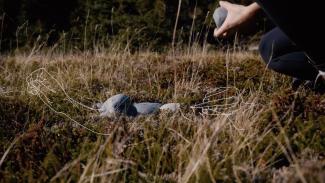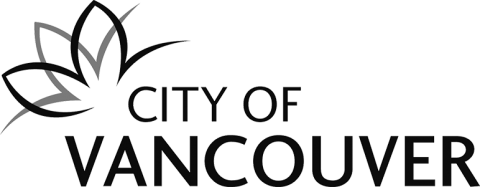A bead, a breath is an exhibition that thinks through caregiving, motherhood, stories, and intergenerational connections, with two videos My Moon (2022) and Our Hands, Our Body, Our Spirit (2022), and sculptural work, BEADZ (2023). Video, animation, and sculpture are grounded in the ongoing and ancestral technology of beadwork—set to ambient scores by Jessie Beier. Continuing generations of Indigenous women’s labour, beadwork mirrors both craft and new media practices in its repetition, rhythm, and storytelling. Carrie Allison says, it “is an act of care, of giving time to, and getting to know; beading is spending time with your ancestors through the shared gesture of sewing and beading.”[i]
At once solitary and shared, the practice of beadwork, like many laborious practices undertaken by women, is done both collectively and in isolation.
Through past community projects, such as The Shubenacadie River Beading Project (2018-2019) and its sister project The Lake Nipissing Beading Project (2020-Present), Allison has initiated exercises “in building treaty relations between settler and Indigenous nations, and humans to mother earth.”[ii] Guided by the Peace and Friendship Treaty that still governs the land of the Mi’kmaq, The Shubenacadie River Beading Project brought together Indigenous and non-Indigenous participants to collectively bead a map of the river.[iii] Allison reflects that such activities “foster storytelling, sharing, engagement, and collective making[,] activating Indigenous research methodologies.”[iv]
With the birth of her child in 2021, Allison turned to beading as a solitary practice, a strategy that carried her through the experience of new motherhood during the height of the COVID-19 pandemic. My Moon is a stop-motion animation of the artist’s beading, set to an audio recording of her newborn’s breath. Through this video, she invites us to join her in exploring ‘a bead, a breath’ as a meditative approach to working through anxiety. As the world slowed, so did she. Combining images “in a painstakingly laborious way, each bead is laid, stitched, a photo taken, then edited, and finally placed in sequence with the sound of my child’s breath.”[v] This breath, along with the in-utero heartbeat, is mixed by Jessie Beier with a number of sources to build the ambient soundtrack. She says, “With each breath and each bead added the growing circle shifts slightly, mimicking the individuality of a breath and the passing of time.”[vi] Could the meticulous act of beadwork be slowed any further than by stopping to document each singular bead? Perhaps only with its own undoing, evidenced in the second video in the exhibition.
Our Hands, Our Body, Our Spirit (2022), documents a three-hour performance by the artist at Middle Cove in Ktaqmkuk (Newfoundland) during a land-based residency through Eastern Edge (an artist-run centre in St. John’s, NL). For the performance, The length of my body beaded in a circle on a visited land (2019), Allison carried rocks up a bluff from the beach below to position them in a circle with a diameter the length of her body. As if untying each bead, she then returned the rocks to the beach, leaving behind an imprint of the rocks—her body, her labour—on the land. “What is the sense of duty that pushes [land artists] to create on spaces that have already been created and lived on? Is it homage? Fascination? Hubris? Perhaps all three? …Is it simply to say, I too was here? ”[vii] Providing a critical antidote to Western notions of ‘Land Art’—the capitalized canon of historically white (often male) artists’ works in the landscape—Allison’s tender imprint makes no more permanent a mark than a footprint.[viii] Her performance isn’t a challenge to nature’s obedience, nor is it a monument to her power. She marks her body on the land, knowing that she is also the land.
The video record of this performance is overlaid with a hand-drawn animation of two hands stitching a bead. Moving in a call and response, the hands’ wavelike motion is reminiscent of the sea below the bluff. The accompanying sound parallels this rhythm and that of her performative gesture—climbing, descending, back and forth. The stones reiterate the shape of the beaded circle in My Moon, her placement of them echoing the stitching of the beads. She says,
“The emotional labour and craft-based labour of Indigenous beadwork artists and caregivers are similarly undervalued, and by bringing together these linked elements of land art and beadwork, I create systems of value according to Indigenous concepts of stewardship.”[ix]
Accompanying these video works are large sculptural BEADZ, which invite the audience, child or adult, to play or rest as they watch the videos. Speaking to her about the process of carving the foam shapes for the beads, I hear her frustration with the slow, messy process of this unpleasant material. Ultimately covered in sewn black fabric, the beads become playful and safe for kids, and once again, her labour is quietly disguised. Their scale adds both humour and humility, putting us in our place, and inviting us to play, rest, and be cared for.
In a bead, a breath, the repetition of the circular form roots us back not only to the bead but to its repeated shape in the land—a circle of beaders, arms around a child, floral centres, the physics of an ocean wave, the moon in our planetary orbit. It is a motif often repeated in Allison’s beadwork. With First Family (2019/20), she made circular beaded depictions of medicinal plants from the area of her maternal roots. With Roses for Elsie (2022), she returned the same approach to her grandmother’s garden to depict the centres of the roses she tended to. In the augmented reality work, Hold Your Circle Close (2021), a single circle of orange beads appears to be suspended in space using the tension of their own stitching.[x] A circle carries many references, but given the global context of the making of this work, I can’t help but draw a connection to Ruth Cuthand’s Trading Series (2008–2009), about which she writes, “beads and viruses go hand-in-hand.”[xi] Cuthand beaded circular images of the pathogens that infected Indigenous populations as a result of colonization. Carmen Robertson writes, “...this relationship to the circle can also be understood as a means of resistance to assimilation and genocide—a symbolic acknowledgement of the rebuilding of Indigenous communities and an embodiment of the land.”[xii] A circle, like Indigenous land stewardship, has no beginning and is unending—a rectangle by contrast, like an imaginary delineation of a parcel of land, starts and stops.
As I draft this text, the SpaceX rocket ship exploded three minutes into its unmanned test flight.[xiii] The relationship between the future and technological advancement to ‘better’ worlds remains a fundamentally Western invention, “And we know how that future not only led to but is based on the colonization of other peoples’ worlds, including their particular perception of technology, humanity, and the environment.”[xiv] As billionaires dream of bringing humans to Mars, and colonization looks to the moon, Carrie Allison’s work invites us to imagine the moon without conquering it. Centring intergenerational care, craft practices, and the land, the work’s connection to Indigenous Futurisms is underscored with Beier’s soundscapes. The composition for Our Hands, Our Body, Our Spirit could score a sci-fi story, pulling us into the slipstream, and releasing us again in waves of atmospheric music.
In each of Carrie Allison’s works, time spent honours anxiety, labour, resistance, and tenderness, connecting her to a lineage of mothering—whether that is caring for a child, taking care of our bodies and communities, attending to our practices, or stewarding the land.
We have an opportunity as witnesses to her work to take this time—to watch her carry the stones, to bead collectively through their accumulation, to play, travel through space and time, to breathe alongside her child—and in so doing, resist.
Katie Belcher, curator
[1] Artist’s website, First Family
[2] Artist’s website, The Shubenacadie River Beading Project
[3] The project culminated in ten metres of beaded pieces that were auctioned off in April 2019 to raise funds for Stop Alton Gas’ legal funds This final auction and support was requested from the community.
[4] From the artist’s website, The Shubenacadie River Beading Project
[5] Artist’s notes, 2023
[6] Artist’s notes, 2023
[7] Asenap, Jason. “Hubris in Art Form: Land artists insist on making their mark on the ancestral grounds of Indigenous people.” ALTA Journal 21 December 2022 https://www.altaonline.com/culture/art/a42042641/land-art-jason-asenap/ (accessed 20 April 2023)
[8] This balance calls to mind BUSH Gallery’s manifesto, which proposes to “trace our impacts on the land in search of balance amidst our inherent selfish humanity.”C Magazine Issue 136 https://cmagazine.com/articles/bush-manifesto (accessed 21 April 2023)
[9] Artist’s notes, 2023
[10] The title for this work references the following quote by Sherry Farrell Racette “Reach deep. Stand tall. Take a breath and tighten that circle around the little and not-so-little ones. It’s all we can do.” on June 24, 2021, following the remains of 215 bodies of children found at Kamloops Residential.
[11] Cuthand, Ruth, from her website https://www.ruthcuthand.ca/trading-series/ (accessed 20 April 2023)
[12] Robertson, Carmen, ”Land and Beaded Identity: Shaping Art Histories of Indigenous Women of the Flatland” RACAR: revue d'art canadienne / Canadian Art Review 42 (2017) 2: 13–29, p.23
[13] Amos, Jonathan “SpaceX Starship: Elon Musk's big rocket explodes on test flight” BBC.com https://www.bbc.com/news/science-environment-65334810 (accessed 20 April 2023)
[14] Pedro Neves Marques, from interview with Grace Dillon, “Taking the Fiction Out of Science Fiction: A Conversation about Indigenous Futurisms” e-flux Journal Issue #120 https://www.e-flux.com/journal/120/417043/taking-the-fiction-out-of-science-fiction-a-conversation-about-indigenous-futurisms/ (accessed 21 April 2023)













